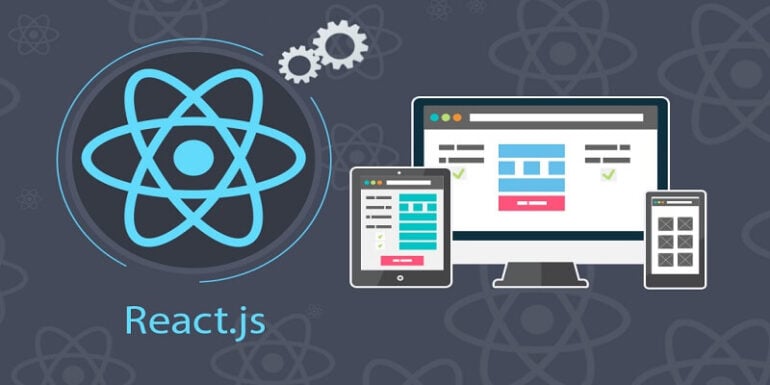- Aug 13, 2020
 0
0- by A2 Dev Team
Web development – and software development in general – has evolved so much in recent years. Today, there are so many options and solutions to consider when it comes to creating a website. If you’re thinking of building interactive elements on a site, and have coding knowledge, the React library is a particularly exciting option.
In essence, React is a library that simplifies the process of building a User Interface (UI) by making use of ‘components.’ React relies mainly on the JavaScript language and has grown to become one of the most popular solutions for front-end web development.
In this article, we’ll examine what React is, its origins, and how it compares with similar options in the web development ecosystem.
An Introduction to the React Framework (And Why You Need It)
JavaScript is one of the major scripting languages used as a core technology in web development. Though HTML and CSS are also major stakeholders, JavaScript has risen to the very top of the ranks, given that it helps to create and control dynamic web content. In fact, a Web Technology Surveys (Web3Techs) report reveals that a whopping 95% of all websites use JavaScript.
On a much wider scale, Statista also found out that JavaScript is the most prevalent programming language worldwide as of early 2020. About 68% of software developers use it.
However, notwithstanding its wide acceptance and popularity, JavaScript doesn’t include everything a developer needs. As such, we’ve seen the recent rise in various front-end frameworks such as Angular and Vue.js.
In simple terms, the React framework is a Javascript library developers use to build user interfaces for single-page web and mobile applications. The major aim of developing React was to improve JavaScript’s User Interface (UI) development. Facebook deployed it for the first time on its News Feed in 2011 and later on Instagram in 2012.
At the core of every React app are components. A React component is a self-contained module that you can use to render a UI output. A typical component can include several other components in its output. In other words, React apps are created by writing components that correspond to different interface elements. An application structure is then defined by organizing the components within other higher-level components.
Why The React Framework Is So Popular
The major advantage React introduced over its predecessors was the introduction of a virtual Document Object Model (DOM). Though not particular to React, a virtual DOM lets the developer implement changes to the document’s data outside the browser. In other words, you can manipulate the document on a DOM built and run entirely in local memory.
Once you’re done with your changes, React intelligently inputs changes from the virtual DOM to the actual browser’s DOM. This in theory offers much better performance.
For a clearer picture, let’s list some reasons why millions of developers around the world choose React.
- React is simple and easy to learn. React’s approach of breaking UI elements down into components makes it attractive to many new developers. React uses a well-defined application structure and a special syntax called JavaScript XML (JSX). JSX makes it possible for developers to mix HTML with JavaScript which makes it much easier to use. In other words, anyone with a basic knowledge of programming can easily learn React unlike ‘domain-specific languages’ such as Angular and Ember.
- React performs better. Over time, React has become very famous for its speed and performance. Thanks to its support for a virtual DOM, performance is significantly better and the applications’ workload is also well-optimized. Likewise, data flows only in one direction in React letting you control the project (and test components) easily.
- There’s a great supportive community. Thanks to the fact that it is open-source and widely adopted, React is backed by a great community. Apart from the availability of React Developer Tools, you can easily find help from other developers if you run into trouble as a newbie.
- React is great for Search Engine Optimization (SEO). Unlike many other JavaScript frameworks, React works very well with SEO. Therefore, your applications will be more accessible to search engines.
However, React would be nothing without its connectivity to the wider development community. Let’s find out more about how React achieves this.
How React Fits into the Web Development Ecosystem
Though originally launched for use with Facebook, React is now enjoying a great rate of adoption across several industries. This doesn’t come as a surprise, as the majority of modern apps rely on reliable UI elements. Many also have a lot of dynamic components.
All these factors make a very good case for the incorporation of React. Let’s quickly take a look at some of the typical projects where you may employ React:
- Social networks. Other social apps such as Instagram, Pinterest, Twitter, and more now depend on React. With the help of Server-Side Rendering (SSR), social sharing and SEO takes on a completely new dynamic. React uses SSR to retrieve relevant information such as the title and author when you’re sharing a post. Being able to have a proper preview is an effective way of rendering your web app. React also offers a lot of benefits when it comes to SEO – a plus for virtually any industry.
- Ecommerce and retail. The reusability of React components makes it an ideal fit for web apps based in e-commerce. Once a developer builds a component on your site, they can reuse the component on a site-wide basis. This saves both time and money on your project. This also positively impacts code maintenance, as the reusability of components helps to avoid code duplicity.
- Cross-platform mobile apps. If you want to build mobile apps for use across different platforms such as Android and iOS, React Native offers a great opportunity. Mobile apps using React Native behave like any other native iOS or Android app. Upgrading a React-based web app to the mobile version is also very easy.
There are several other project types where the adoption of React has proven ideal. Sharing economy apps (Airbnb, Uber, Lyft), video platforms (Netflix), and SaaS tools (Zapier) all incorporate React.
Of course, WordPress has also adopted React through other frameworks such as Frontity, and Matt Mullenweg’s initial insistence to “Learn JavaScript deeply” should also include a React-based approach to creating WordPress products too.
Conclusion
If you’re looking forward to working as a front-end web developer, learning React is definitely a great idea. There are a lot of benefits to using the library, and it enjoys immense popularity only a few years after its release.
React’s dependence on JavaScript and the idea behind components make it very easy to adapt. There are also other features like the virtual Document Object Model (DOM) and renderers that make React deliver great runtime performance.
Image credit: React Plus.












